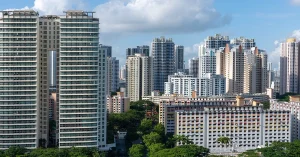By 2025, Indian luxury real estate is no longer the preserve of a niche elite. It extends to major metros and second-tier cities, driven by growing prosperity, policy reform, and changing investment mindset. High-net-worth individuals (HNWIs) and non-resident Indians (NRIs) continue to drive growth. India’s economy, set to grow at around 6–6.5% this year, provides robust underlying support.
Table of Contents
The Reserve Bank of India’s accommodative policy—cutting the repo rate to 6% in April—yet again drove borrowing and investment. Luxury real estate today is a strategic asset class, particularly appealing in the face of uncertainty in the equity markets.
Factors Influencing Luxury Real Estate in India
In 2025, its growth is being shaped by macroeconomic trends, policy reform, buyer decisions, and changing urban dynamics. In this blog, we’re going to take a look at the Factors affecting luxury real estate in India.
Trends in Luxury Real Estate
Luxury housing continues to outperform broader residential segments. Economic Times reported that homes priced ₹4 crore+ saw 28% year-on-year growth in Q1 2025, with unit sales rising from ~1,510 to 1,930 across India’s top seven cities. Delhi-NCR led with 49% of sales, followed by Mumbai and Bangalore.
Much of this demand stems from lifestyle upgrades and wealth expansion, but developer strategies have also shifted. Builders now focus on ultra-premium offerings: plotted villas, gated communities, and second homes with extensive amenities. Ready-to-move-in units from reputed builders are particularly favored.
Colliers India notes luxury demand will likely outpace affordable and mid-income housing in 2025. Pricing has responded accordingly—Mumbai’s luxury prices rose ~10% year-on-year, while Bangalore and Delhi also saw appreciation. Measured launches and constrained inventory have helped maintain price stability.
Meanwhile, Tier-II and Tier-III cities are entering the luxury map. Cities like Amritsar, Ayodhya, and Dwarka are seeing more organized luxury development due to infrastructure growth and religious tourism. NRIs and wealthy locals are increasingly buying premium apartments in these emerging pockets.
We can observe the concept of luxury evolving as it’s no longer just about opulence, but about sustainability, privacy, and tech integration. According to TheLuxuryEstates, 60% of buyers prioritize energy-efficient features, and 75% demand smart-home automation. Amenities such as air purification, meditation zones, concierge services, and wellness facilities are now standard expectations.
Buyers also seek privacy and natural settings—hill stations, waterfronts, or low-density gated communities and these things are deciding the Luxury real estate market trends. Developers are incorporating these demands with soundproofing, biophilic design, and exclusive club memberships. Luxury in 2025 is about lifestyle and values, not just square footage.
Sustainability and ESG Influence on Luxury Real Estate
With climate awareness on the rise, sustainability is no longer optional in India’s luxury housing market. Environmental, social, and governance (ESG) factors are playing a bigger role in both design and investor decisions. Buyers now ask about LEED or IGBC certification, rainwater harvesting, energy efficiency, and carbon neutrality.
In 2025, more luxury projects are meeting or exceeding these benchmarks. Developers are incorporating green roofs, organic waste composting, solar panels, and even vertical forests into premium properties. A survey by The Confederation of Real Estate Developers’ Associations of India (CREDAI) shows that 58% of affluent homebuyers in metros now consider sustainability a top-three priority in home purchase decisions. The shift reflects broader global trends where responsible development and ecological footprint affect both reputation and ROI.
Institutional investors and private equity firms also view ESG-aligned projects as less risky and more resilient. Luxury housing in India, thus, is adapting to a new paradigm where being green is a competitive advantage – and a symbol of progressive affluence.
Profile of the Indian Luxury Buyer
Today’s luxury homebuyers are global citizens—many are NRIs, tech entrepreneurs, CXOs, or finance professionals with global real estate exposure. They value trophy assets, security, and lifestyle over mere aesthetics.
According to Colliers, this group seeks best-in-class features and long-term capital appreciation. For many, a luxury home is part of a diversified investment portfolio. The House of Abhinandan Lodha notes rising interest in ₹5+ crore land parcels in secure gated communities. Such buyers value exclusivity and community, treating their homes as both private sanctuaries and wealth-preserving assets.
Importantly, they are more discerning. They research developers, inspect compliance under RERA, demand sustainability certifications, and negotiate hard. The average luxury buyer today is digitally savvy, cautious, and willing to pay a premium only for genuine value.
NRI Demand and Offshore Capital Inflows
The Indian diaspora remains the driving force behind demand for luxury real estate in India. With more than 32 million Indians abroad, of which many hold high-income professional or entrepreneurial positions, NRIs are a significant target segment for luxury property. A weak rupee and greater digitalization of property sales have further consolidated offshore demand.
As per ANAROCK, Indian residential real estate NRIs’ investment increased by 12% in 2024, with luxury and ultra-luxury segments contributing close to 40% of the spending. Metros such as Mumbai, Hyderabad, Pune, and Ahmedabad are seeing continued NRI interest, particularly in ready-to-move properties offered by renowned developers. NRIs tend to seek homes in India for reasons beyond just investment – sentiment, family connections, and retirement or vacation home needs guide choices.
In 2025, builders are going all out to customize products for this segment by introducing virtual site tours, easy KYC procedures, and even foreign roadshows. For US-based, UAE-based, Canadian, and British HNWIs, Indian realty continues to be a sought-after long-term investment asset – combining individual usability with asset preservation.
Role of Technology in Enhancing the Luxury Experience
Another crucial consideration guiding buyer tastes in 2025 is the flawless incorporation of technology in luxury residences. From intelligent lighting and temperature control to artificial intelligence-based security systems and virtual concierge applications, the technological upgrade of luxury homes has reimagined luxury. Wealthy buyers today demand not only looks, but smart functionality as well.
Indeed, a report in 2024 by CBRE stated that more than 70% of new launches of luxury homes in India now come equipped with home automation as an integral offering. This encompasses touchless access, voice-activated devices, integrated home entertainment systems, and even predictive energy management systems that assist with sustaining ecological balance. Upscale buyers are placing greater emphasis on technology as an enabler of lifestyle – a trend that mirrors wider changes in the urban Indian lifestyle and work culture.
Post-pandemic, with remote work and hybrid lifestyles a reality, most luxury buyers are looking for smart, safe, and tech-enhanced homes that facilitate productivity, wellness, and recreation all under one roof. For developers, this is an opportunity to push the innovation envelope while attracting young HNIs who are technology-savvy.
Government Policy and Regulatory Environment
Government policies affecting real estate 2025, as key reforms over the past decade—especially RERA and relaxed FDI norms—have reshaped luxury real estate. RERA mandates project registration, escrow management, and penalties for delays, providing greater protection for buyers. Luxury projects, involving high financial stakes, benefit from the transparency and legal safeguards this framework provides. Business Today notes RERA and FDI have encouraged accountability and innovation in the segment.
Policy-wise, the 2024 Union Budget focused on boosting housing overall. ₹10 lakh crore was earmarked for urban housing schemes, and states were encouraged to cut stamp duties—directly reducing transaction costs. In states that complied, sales rose. Even though affordable housing was the primary target, the positive spillover benefited mid- and high-end segments too.
Looking ahead, industry bodies expect the 2025 Budget to raise home loan interest deductions and simplify GST on construction. Digitization of land records, eased REIT norms, and FDI liberalization are also helping luxury developers launch projects with more clarity and less red tape. With improved infrastructure, tax support, and regulatory transparency, India’s real estate sector has become more investor-friendly, even at the ultra-premium end.
Conclusion
In 2025, India’s luxury real estate market is buoyant on account of several Luxury real estate market trends factors: solid economic foundations, level of sophistication of buyers, policy transparency, and a wide definition of luxury. Demand is strong in metros and seeping into Tier II cities, as buyers focus on privacy, health, and intelligent features. NRIs enjoy currency benefits, while domestic HNWIs view real estate as a bet hedge against market fluctuations.
Regulatory improvements—RERA, digitization, and FDI reforms—have boosted transparency and reduced risk. Meanwhile, lower interest rates and policy support continue to drive capital toward premium properties.
Ultimately, India’s luxury housing market is no longer aspirational—it’s strategic. For investors, developers, and buyers alike, 2025 marks a turning point where luxury real estate is not only desirable but also decisively future-proof.
FAQs About Luxury Housing
Q2. How do interest rates affect luxury housing demand?
Interest rates can play a vital role in determining the Indian luxury housing demand as lower interest rates reduce borrowing costs, making it easier for buyers to take large home loans. The RBI’s accommodative policy in 2025 has led to cheaper EMIs, improving sentiment and encouraging investments in premium properties.
Q3. Are NRIs actively investing in India’s luxury property market?
Yes, NRIs are increasingly buying luxury homes in India due to a weaker rupee (which boosts value for foreign currency holders), transparent regulations, and emotional ties to their home country. Prime city properties and second homes are in high demand.
Q4. What kind of features are luxury homebuyers demanding in 2025?
In the latest year of 2025, luxury home buyers now look for smart-home automation, wellness amenities, sustainable design (like green buildings and solar energy), high-grade security, and proximity to work hubs or social infrastructure.
Q5. Is luxury real estate a good investment in 2025?
Yes, especially for long-term wealth preservation and appreciation. With real estate investment factors like stable policies, increasing demand, and limited supply, many investors and HNWIs view luxury properties as a resilient and appreciating asset class.








